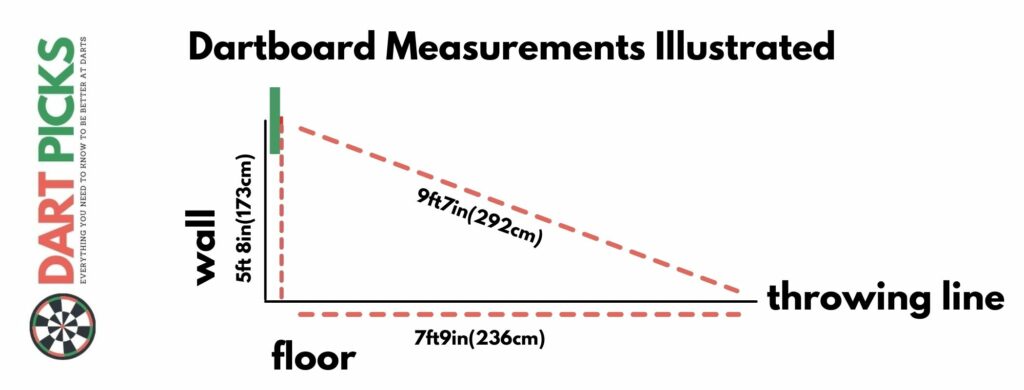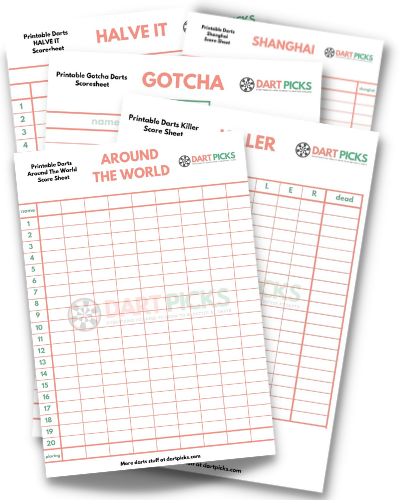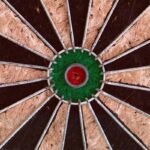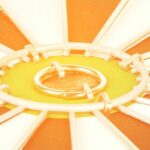It’s not rocket science and it doesn’t require an engineering degree, but hanging a dartboard on drywall does take some planning to do it right.
The following is a complete guide to hanging a dartboard on drywall; it’s packed with tips and observations from someone who has put up hundreds of boards over the years.
Table of Contents
Can you hang a dartboard on drywall (plasterboard)?
Yes! You can hang a dartboard on drywall if you use the right type of hangers and follow a few simple tips.
First, make sure to use hollow-wall anchors rather than screws, which could break through the drywall.
Second, make sure you use some kind of wall protection as darts can easily damage a drywall.
Finally, you need to be aware that playing darts using a board attached to a drywall can be noisy, however, there are some steps you can take to reduce the “thuds” (see below).
Why is Drywall Different?
Drywall (also known as plasterboard) is a budget-friendly alternative to more robust building materials.
Most drywall will hold about 20lbs just with a basic nail in the wall. A dartboard is rarely heavier than 10 or 12 lbs but there are some caveats.
When collecting your darts from the board you want to be able to pull them out and not worry about the board coming with them! Nor do you want to have to support the board with your other hand while removing your arrows.
This is why we need more than 20lbs of security keeping your board in place.
What About Noise?
Hanging a dartboard directly onto drywall is similar to simply amplifying the thudding sounds when your darts hit the board. This may not be a concern if you live alone but if there’s a chance that could annoy someone, there’s a very real possibility that it will.
Insulation is advisable when mounting a dartboard onto drywall. There’s a number of different materials you can use for this but these are some of the most effective we’ve used:
- Cork
- Darts backboard
- Dartboard cabinet
- 2×4
- Carpet
Or indeed, any combination of the above that works for you. Got some leftover carpet from your recent home improvement project? Perfect!
Choose the Best Position for your Board
Before mounting any dartboard, you need to first decide where it’s going to go. You need space around and in front of your board. Aim for an area at least 7 feet wide, and 12 feet long. Some things to keep in mind:
- Darts can bounce out up to 8 feet
- Avoid cluttered areas full of furniture
- Avoid putting dartboards next to doorways
- Consider a backboard to protect your wall
- Consider a mat to protect your floor (and also a ready made oche).
Measure, Measure and Measure Again
Most dartboards come with a centralized mounting system that makes it straightforward to measure and attach your mount to the surface in a central position exactly 5’8” from the ground to the bullseye.
Your oche (or throw line) should be 7’9” from the wall. These are measurements for steel stip darts. For electronic dartboard measurements, check this diagram:

There is nothing more frustrating than mounting a dartboard then realizing you made a mistake with your measurements. To avoid any unnecessary holes in the wall and a LOT of wasted time and effort, make sure to measure everything repeatedly before you start drilling holes.
If you are mounting a dartboard that is to be mounted to the top of the board, measure from that point to the bullseye. then add that measurement to 5’8” to accurately find the spot you’ll need to attach to the wall.
For more extensive information on how to correctly measure up for your board check out our article Dartboard Measurements.
Selecting the Best Position on Your Drywall
If you have the luxury of choosing a spot on your wall, aim to find the studs.
Studs are the supporting wood behind the drywall. These can be found easily by tapping on the drywall until the sound is not hollow.
If you are unsure of the locations of pipes and wires behind your drywall, we highly recommend investing $20 in a tool that scans the wall.
These devices can help you avoid hitting electrical wiring and plumbing when mounting your dartboard.
Wall Anchors Are Essential
Wall anchors (or rawl plugs) are a must for a secure fitting to your drywall. Some considerations are to make sure your wall anchors are sufficient size to hold the screws supplied for your dartboard. You may find it easier to replace the included dartboard screws with ones that fit but are longer and/or stronger.
Wall anchors can even be used without an electric drill if they are self-drilling. You can screw them directly into the wall without the need of a drill.
These wall anchors will ensure a secure fitting for your board and greatly increase the weight capacity of your mount.
Backboard and Cabinets
Using a backboard or cabinet will reduce the noise of your darts and protect the surrounding area from stray darts. If mounting a cabinet, make sure to use a spirit level.
You should have no problems hanging a backboard or a cabinet on drywall if you follow the rest of the advice.
Final Words
Drywall can present some challenges for the darts enthusiast, but with some common sense, accurate measurements, and insulation, you can effectively mount your dartboard and have peace of mind that it’ll stay there! Let u know how you got on.
Check out our article on darts mats to complete your setup.
Sue has been playing darts since her 20’s when she played in weekly tournaments and she enjoys writing about darts. She’s also a great teacher, and she enjoys helping others learn how to play the game well. When Sue isn’t throwing darts, she enjoys spending time with her family and friends.
The easy way to keep track of your score is with our printable darts scoresheets. Easy to download and keep on your phone or computer or print straight off from our website. Pop your email address into the box and we'll send them straight to you.








